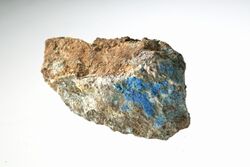Chemistry:Ashburtonite
| Ashburtonite | |
|---|---|
 | |
| General | |
| Category | Cyclosilicates |
| Formula (repeating unit) | HPb4Cu4Si4O12(HCO3)4(OH)4Cl |
| Strunz classification | 9.CF.05 |
| Crystal system | Tetragonal |
| Crystal class | Dipyramidal (4/m) H-M symbol: (4/m) |
| Space group | I4/m |
| Unit cell | a = 14.23, c = 6.1 [Å]; Z = 2 |
| Identification | |
| Color | Blue |
| Crystal habit | Prismatic, needle like in clusters |
| Cleavage | None |
| Fracture | Conchoidal |
| Tenacity | Brittle |
| |re|er}} | Vitreous to adamantine |
| Streak | light blue |
| Diaphaneity | Transparent |
| Specific gravity | Greater than 4.07, calculated 4.69 |
| Optical properties | Uniaxial (+) |
| Refractive index | nω = 1.786 nε = 1.800 |
| Birefringence | 0.0140 |
| References | [1][2][3][4] |
Ashburtonite is a rare lead copper silicate-bicarbonate mineral with formula: HPb4Cu2+4Si4O12(HCO3)4(OH)4Cl.[4]
Geological occurrence
Ashburtonite was first described as a secondary mineral in a shear zone in a series of shales and graywackes. It is an alteration product of galena and chalcopyrite.[3] The secondary minerals within the shear consist of carbonates, arsenates, and sulfates of lead and copper, and to a much lesser extent of zinc and iron.[4] Ashburtonite is associated with beudantite, brochantite, caledonite, cerussite, diaboleite, duftite, malachite, plattnerite, adamite, antlerite, bayldonite, bindheimite, carminite, chenevixite, chlorargyrite, chrysocolla, cinnabar, hemimorphite, hydrozincite, jarosite, lavendulan, linarite, mimetite, olivenite, paratacamite, and rosasite.
Ashburtonite was first described in 1991 for an occurrence in the Anticline prospects 11 km (6.8 mi) southwest of Ashburton Downs in the Capricorn Range of Western Australia.[3] It has also been reported from the Tonopah–Belmont Mine in the Big Horn Mountains of Maricopa County, Arizona.[2]
References
- ↑ Webmineral
- ↑ Jump up to: 2.0 2.1 Mindat
- ↑ Jump up to: 3.0 3.1 3.2 Handbook of Mineralogy
- ↑ Jump up to: 4.0 4.1 4.2 Grice, J. D.; Nickel, E. H.; Gault, R. A. (1991). "Ahsburtonite, a new bicarbonate-silicate mineral from Ashburton Downs, Western Australia: Description and structure determination". American Mineralogist 76: 1701–1707. http://rruff.info/rruff_1.0/uploads/AM76_1701.pdf.
- ↑ Warr, L.N. (2021). "IMA–CNMNC approved mineral symbols". Mineralogical Magazine 85 (3): 291–320. doi:10.1180/mgm.2021.43. Bibcode: 2021MinM...85..291W.
 |

